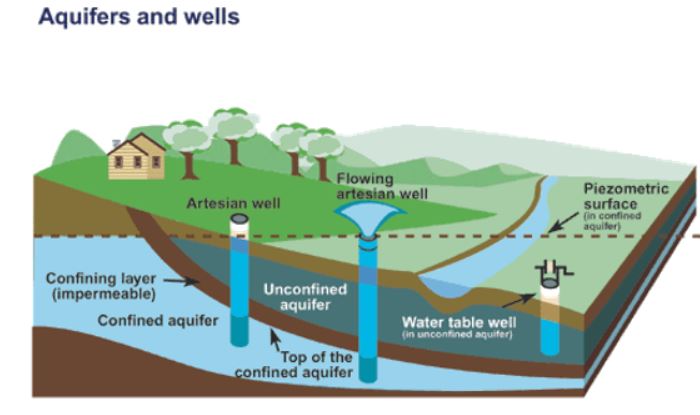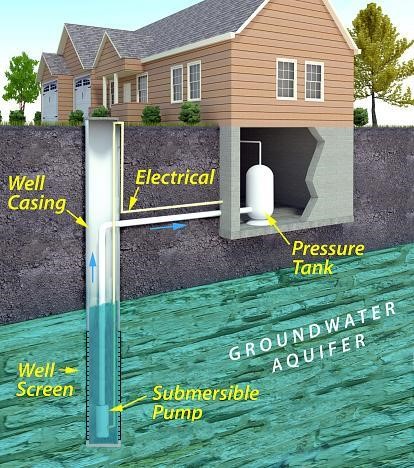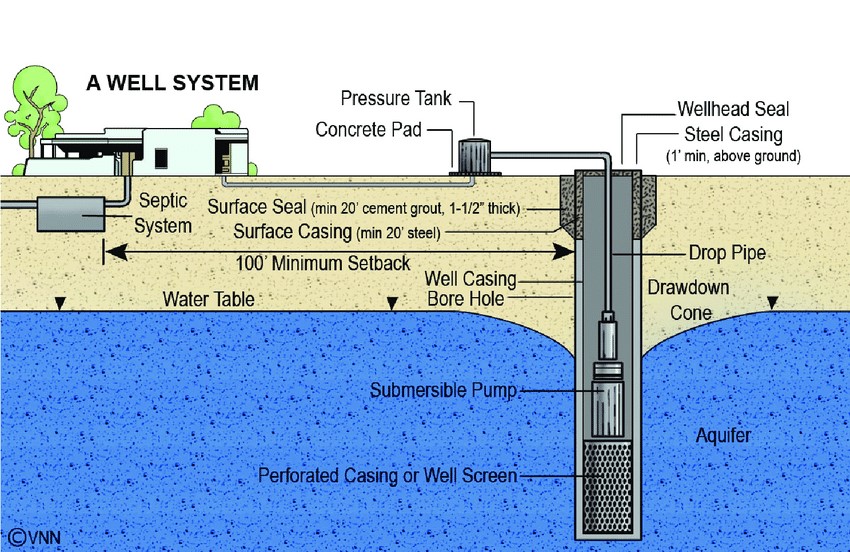For National Groundwater Awareness Week, today we explain what aquifers are, where they are, how to we get water from them, and some important measures for protecting our groundwater supplies and your well water. More information can be found on the UGA Extension publication “Protecting Your Well and Wellhead” (Circular 858-1).Written by Gary L. Hawkins and Martin Wunderly.
Aquifers are defined in the Meriam-Webster Dictionary as “a water-bearing stratum of permeable rock, sand, or gravel.”
As the definition says, an aquifer is a water bearing stratum. In the following picture from USGS, the aquifer is anything below the water table.

The way we get water from an aquifer is typically by installing a well. Yesterday we showed a picture of wells drilled into the different aquifers. Here is the picture from USGS again in case you missed yesterday’s posting.

When a well is drilled for a home, it could look like this image from the USGS or Arizona Extension Publication AZ1451:


As the following image from Zaporozec and Miller (2000) shows, groundwater contamination can originate from many sources.

Image from: https://www.grida.no/resources/13721 , created by Zaporozec, A. and Miller, J.C. (2000) Groundwater Pollution. UNESCO-PHI, París, 1-24.
Protection of groundwater is important to reduce potential risk to the homeowner and other users of the aquifer. Protection of the groundwater starts at the well by installing a proper well cap to protect the aquifer from surface water, vermin (insects, rodents, other animals, or anything that could fall in the well), fertilizers, herbicides, and pets. The following pictures shows some examples of well caps that can be used.


Another way to protect the aquifer is to pour a concrete pad around the well and make sure there is a grout seal below the pad to reduce the potential of water flowing next to the well and down the edge of the well casing and into the aquifer. Here is an image of such a pad provide by E. Rooks.

To further protect your well here are some tips for protecting your drinking water well head:
Maintain the area around the well to be clean and accessible.
- Do not store any chemicals, gasoline, or fertilizer within 50 feet of the well.
- Divert surface water away from the well. Install a water tight curbing, sloping away from the casing that is sufficient to prevent contamination.
- Protected the upper terminal of the well by a sanitary seal or cover to prevent entrance of pollutants to the well.
The following horizontal distances should be maintained between your well:
- Not less than ten (10) feet from a sewer line
- Not less than 50 feet from a septic tank
- Not less than 100 feet from a septic tank absorption field
- Not less than 150 feet from a cesspool or seepage pit
- Not less than 100 feet from an animal or fowl enclosure
Today we looked at what aquifers are, where they are, how to we get water from them, and some important measures for protecting our groundwater supplies and your well water.
Some of the images were used from:
- https://s3.amazonaws.com/treehouse-content/uploads/before_after/3630/large/well-cap-after.jpg
- https://wellwater.oregonstate.edu/sites/wellwater.oregonstate.edu/files/well_colored_13.jpg
Some of the resources that could be useful and are mentioned here are:
- Protecting Your Well and Wellhead – UGA CAES Circular 858-1
- Well Owners’ Guide To Ground Water Resources In Gila County — (https://extension.arizona.edu/sites/extension.arizona.edu/files/pubs/az1502.pdf)
- Well water webinars by Hawkins and Butcher on Water at UGA website (https://site.extension.uga.edu/water/well-water/)
- https://www.grida.no/resources/13721 , created by Zaporozec, A. and Miller, J.C. (2000) Groundwater Pollution. UNESCO-PHI, París, 1-24.
Tomorrow we will look at —Testing your well water
#UGAWater, #UGAExtension